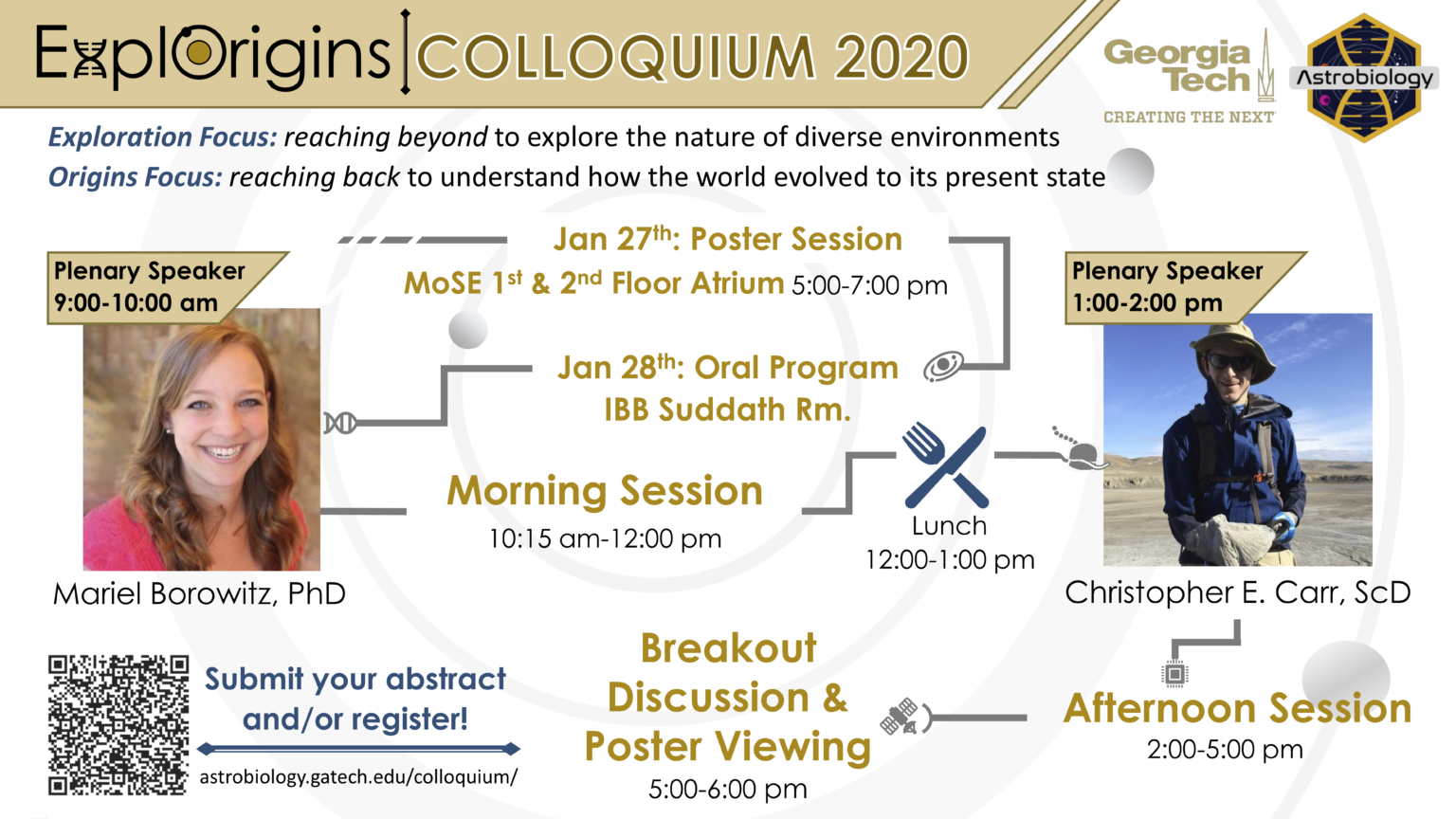Presentations | Posters
A selection of permitted presenter titles and abstracts have been published below.Plenary Speakers
Dr. Christopher E. Carr
The synthesis of complex organic molecules, including the building blocks of life as we know it, occurs in stellar nebulas, in reducing planetary atmospheres, and through aqueous reaction networks. To the extent that this chemistry is universal, life elsewhere may also utilize amino acids, and nucleic acids or related informational polymers (IPs) for information storage and heredity.
Earth and Mars have exchanged an estimated billion tons of rock due to large meteorite impacts. If life exists on Mars, it could be related to us. Such an assumption is unlikely to hold for any life within Saturn’s moon Enceladus, or at Jupiter’s moon Europa. Here we describe progress towards life detection beyond Earth via single molecule sequencing of nucleic acids: a Search for Extra-Terrestrial Genomes (SETG). We also describe preliminary work to develop the Electronic Life-detection Instrument for Enceladus/Europa (ELIE), which would utilize nanogaps as a solid-state single molecule detector that is agnostic to the precise target chemical identity, extending detection capabilities from life as we know it to life as we don’t know it.
Dr. Mariel Borowitz
The field of astrobiology, with roots more than 100 years old, evolved quickly after the establishment of the National Aeronautics and Space Administration (NASA). This talk explores how the evolution of the field was influenced not only by important developments in science and technology, but also by political and policy issues and decisions. It traces the development of the field over the last sixty years and ends with some discussion of new directions going forward.
Presentations
Dr. Micah Schiable — Chemistry and Biochemistry
The distribution of material throughout our Solar System can place strong constraints on the possible dynamical and thermal histories of small bodies. Only by obtaining a measurement of the large-scale compositional distribution in various regions of the Solar System can questions regarding the origins and history of many small bodies begin to be addressed. Additionally, having a means to rapidly characterize the elemental compositions of bodies could help identify valuable resources for exploration and in situ resource utilization purposes.
The composition of bodies can only be loosely constrained using typical reflected light spectroscopy techniques. Although sample return is the best means of determine details of composition and formation conditions for bodies, it is costly, risky, and limited to a small number of sampling locations. A robust and sensitive technique for obtaining elemental composition of surfaces in high vacuum environments is the collection and analysis of secondary ions ejected due to solar wind and magnetosphere ion sputtering and meteorite impacts. First proposed for space based compositional analysis over 30 years ago [Managadze and Sagdeev, 1988; Johnson and Baragiola, 1991], this technique is commonly known in the laboratory as SIMS and can achieve excellent signal to noise ratios due to low ion backgrounds and high detection sensitivities achievable. Additionally, SIMS measurements at small bodies can help resolve whether these bodies harbor any potentially valuable resources for future exploration missions and how the composition of rocky asteroids varies throughout the Solar System.
Kelvin Smith — Chemical and Biomolecular Engineering
My research focuses on the investigation of the relevant kinetic mechanisms of chiral depsipeptide polymerization and degradation. Once these depsipeptide mechanisms are identified, you can predict behavior of similar peptides used to create biopolymers for pharmaceutical purposes such as drug delivery and tissue engineering. The model provides helpful predictions for future synthesis of other depsipeptides, and it consists of a complex Kinetic Monte Carlo (KMC) framework that simulates growth and degradation of chiral depsipeptides. To use the framework, rate constants of relevant mechanisms must be known a priori through either experimental data or a literary search. To investigate the kinetic mechanisms of ester reactions in depsipeptides, high performance liquid chromatography (HPLC) data of two test molecules are collected and quantified at different pH values and temperatures: multiple oligomers of an HO-dipeptide called glycolic acid alanine (gA) and a methylated molecule of the gA dimer called propionic acid alanine glycolic acid alanine ((PA)AgA). I model and simulate the evolution and degradation of gA using MATLAB to extract rate constants. These degradation rate constants come from a novel model structure that describes two hypothesized mechanisms: scission and backbiting. I perform statistical procedures to determine how good the model fits are to the data, how likely one mechanism describes a model over another, and how confident we can be in the predicted values. Preliminary results show that both scission and backbiting rate constants of the gA oligomers and (PA)AgA follow an Arrhenius relationship and that backbiting is a dominant degradation mechanism at basic pH values in gA oligomers. When the rate constants were plotted against pH, similar behavior can be found in the literature.
Petar Penev — Biological Sciences
The ribosome’s common core connects all life back to a common ancestor and serves as a window to relationships among organisms. In eukaryotes, the common core contains expansion segments (ES’s) that vastly increase ribosomal RNA size. Supersized ES’s have not been observed previously in Bacteria or Archaea, and the origin of eukaryotic ES’s remains enigmatic. We discovered that the large subunit rRNA of Lokiarchaeota, the closest modern cell lineage to the last common ancestor of Archaea and Eukarya, bridges the gap in size between prokaryotic and eukaryotic rRNA. The long large subunit rRNA in Lokiarchaeota is largely due to the presence of two eukaryotic-like, supersized ES’s, ES9 and ES39, which are transcribed in situ. We applied computational models, covariation analysis, and chemical footprinting experiments to study the structure and evolution of Lokiarchaeota ES9 and ES39. We also defined the eukaryotic ES39 fold for comparison. We found that Lokiarchaeota and eukaryotic ES’s are structurally distinct: Lokiarchaeota ES39 has more and longer helices than the eukaryotic ES39 fold. Despite their structural differences, we found that Lokiarchaeota and eukaryotic ES’s originated from a common ancestor that was “primed” for evolution of larger and more complex rRNAs than those found in Bacteria and other archaea.
Dr. Anthony Burnetti
Phototrophy – the ability of a cell to capture light energy for metabolism – is responsible for the vast majority of biomass production and metabolic flux on Earth, and its origin represents an extremely important evolutionary transition. This capability has evolved independently exactly twice in Earth’s history, via chlorophototrophic and retinalophototrophic machinery. Close examination of the properties of these metabolic pathways reveals them to be remarkably complementary in their chemical makeup and ecological roles, suggesting that their properties are the result of ancient ecological interactions between incumbent and novel phototrophs filling initially vacant ecological niches rather than being the random results of rare, difficult innovations. Each origin of phototrophy has filled a particular niche in the tradeoff between efficiency per unit light and efficiency per unit protein infrastructure, and has suppressed the evolution of novel machineries like themselves while failing to suppress each other due to their fundamental architectural differences.
As a “dual evolutionary singularity”, phototrophy can also be used as a touchstone to understand the dynamics of major evolutionary innovations and transitions in the history of life on Earth. Many innovations, such as the singular origin of eukaryotes or the origin of life itself, occurred exactly once and transformed the planet. Others, like the evolution of multicellularity, have occurred many times. This could be due to some innovations being intrinsically rare or difficult, or evolutionary singularities could be singular as a result of ecological interactions by first-movers suppressing innovation by other lineages. The example of phototrophy suggests that many of these singularities could be simpler to evolve than they seem, and could be common in other biospheres.
Aaron Pital
The pace of publication in the sciences has long since outstripped human ability to read and synthesize information. While interdisciplinary work can mitigate some of this burden, there remain fundamental questions about whether attentional blindness and the opportunity cost of reaching beyond the comfort of one’s expertise hold back innovation in speculative fields such as the origins of life. We present a brief model of associative information in scientific publication and propose tools derived from information theory, natural language processing, and data science to search for physical and chemical contexts embedded in literature from fields as diverse and non-traditional as soil science and drug design. The goals of these efforts are 1) to identify physical and chemical information of interest to origins of life researchers which would otherwise be unlikely to rise to the community’s attention and 2) to define rules for correlated information generally to improve literature cataloging, referencing and retrieval.



